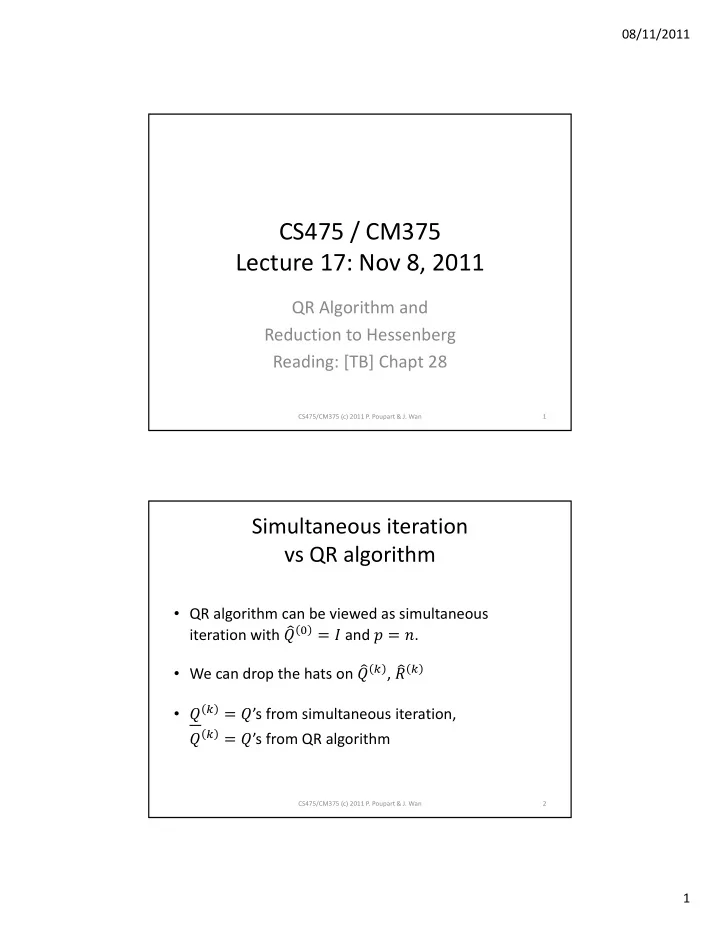

08/11/2011 CS475 / CM375 Lecture 17: Nov 8, 2011 QR Algorithm and Reduction to Hessenberg Reading: [TB] Chapt 28 CS475/CM375 (c) 2011 P. Poupart & J. Wan 1 Simultaneous iteration vs QR algorithm • QR algorithm can be viewed as simultaneous � � � � and � � � . iteration with � � � , � � � • We can drop the hats on � • � � � � ’s from simultaneous iteration, � � � � ’s from QR algorithm CS475/CM375 (c) 2011 P. Poupart & J. Wan 2 1
08/11/2011 Simultaneous iteration revisited • Simultaneous iteration can be written as: � � � � For � � 1,2, … � � ← �� ��� � � � � ← � � � � � � � � �� � New matrices for proof purpose � � � � � � ��� … � � end CS475/CM375 (c) 2011 P. Poupart & J. Wan 3 QR algorithm revisited • QR algorithm can be written as: � � � � For � � 1,2, … � � � � ← � ��� � � ← � � � � � � � � � � � … � � New matrices for proof purpose � � � � � � ��� … � � end CS475/CM375 (c) 2011 P. Poupart & J. Wan 4 2
08/11/2011 Equivalence • Theorem: The two algorithms generate identical sequences of matrices � � , � � and � � and they are (1) � � � � � � � � (2) � � � � � �� � CS475/CM375 (c) 2011 P. Poupart & J. Wan 5 Equivalence • Proof: by induction. The case � � 0 is trivial since � � � � � � � � � � and � � � � . Suppose it is true for � � 1 . Simultaneous iteration: CS475/CM375 (c) 2011 P. Poupart & J. Wan 6 3
08/11/2011 Equivalence • Proof continued… QR algorithm: CS475/CM375 (c) 2011 P. Poupart & J. Wan 7 Convergence of the QR algorithm (1) ⟹ QR algorithm effectively computes � , � factors of � � i.e., orthonormal basis for � � (2) ⟹ The diagonal of � � are Rayleigh quotients of column vectors of � � • As columns of � � ⟶ eigenvectors, the Rayleigh quotients ⟶ eigenvalues CS475/CM375 (c) 2011 P. Poupart & J. Wan 8 4
08/11/2011 Convergence of the QR algorithm � � � � � � � � • � �� ��� � � , � � � are columns � and � of � � – Here � � � → � � , � � � → � � , �� � � � � � � � – Eventually � � � � � � � � � � � � 0 ∀� � � – Therefore � �� • ∴ � � converges to a diagonal matrix CS475/CM375 (c) 2011 P. Poupart & J. Wan 9 Convergence of the QR algorithm • Theorem: Assume � � � � � � ⋯ � |� � | and � has all nonsingular leading principal minors. As � → ∞ , � � converges linearly to ������ � , … , � � � and � � converges at the same rate to � . The rate of convergence is � ��� � � max � � � CS475/CM375 (c) 2011 P. Poupart & J. Wan 10 5
08/11/2011 Example 2 1 1 � � � • � � 1 3 1 1 1 4 CS475/CM375 (c) 2011 P. Poupart & J. Wan 11 Example 21 7 �1 � � � • � � 5 7 7 4 �4 20 CS475/CM375 (c) 2011 P. Poupart & J. Wan 12 6
08/11/2011 Practical QR • It is expensive to compute the QR � � � � ����� factorization of a square matrix • In practice, we first reduce � to a Hessenberg matrix if � � � � and to a tridiagonal matrix if � � � � • The resulting QR factorization would be ��� � � if � � � � and ���� if � � � � CS475/CM375 (c) 2011 P. Poupart & J. Wan 13 Reduction to Hessenberg or Tridiagonal • The matrix can be nonsymmetric in general • Why Hessenberg? Why not triangular? CS475/CM375 (c) 2011 P. Poupart & J. Wan 14 7
08/11/2011 Reduction to Hessenberg or Tridiagonal � that leaves 1 st row • Be less ambitious and choose � � unchanged CS475/CM375 (c) 2011 P. Poupart & J. Wan 15 Reduction to Hessenberg or Tridiagonal • In general: � � � � � � … � ��� and � � �� � upper Hessenberg • Complexity: �� � � � – Flops(Reduction to Hessenberg) � � � � � – Flops(Reduction to tridiagonal) � CS475/CM375 (c) 2011 P. Poupart & J. Wan 16 8
Recommend
More recommend